Everyday Mathematics 2nd Grade Answer Key Unit 4 Place Value and Measurement
Everyday Math Grade 2 Home Link 4.1 Answer Key
Telling Time to the Half Hour
Family Note
Today we reviewed telling and writing times to the hour and half hour on an analog clock. We discussed the movement of the hour and minute hands and units of time such as hour and minute.
Please return this Home Link to school tomorrow.
Write the time shown on each clock.
Question 1.
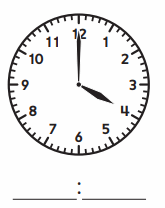
Answer:

4:00,
Explanation:
The time shown on the clock is 4:00.
Question 2.
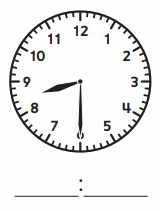
Answer:

8:30,
Explanation:
The time shown on the clock is 8:30.
Question 3.

Answer:
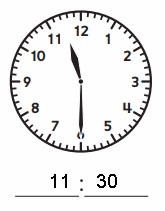
11:30,
Explanation:
The time shown on the clock is 11:30.
Draw the hour hand and the minute hand to show the time.
Question 4.
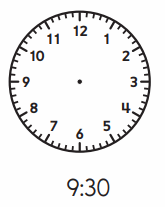
Answer:
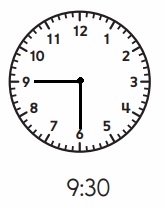
Explanation:
Drawn the hour hand as 9 and the minute hand at 6
to show the time as 9:30.
Question 5.

Answer:
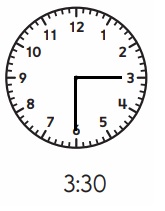
Explanation:
Drawn the hour hand as 3 and the minute hand at 6
to show the time as 3:30.
Question 6.
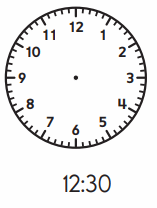
Answer:
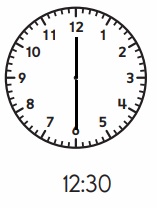
Explanation:
Drawn the hour hand as 9 and the minute hand at 6
to show the time as 9:30.
Practice
Question 7.
6 + 5 = __11_
Answer:
6 + 5 = 11,
Explanation:
Adding 5 to 6 we will get 11.
Question 8.
_4_ + 3 = 7
Answer:
4 + 3 = 7,
Explanation:
Subtracting 3 from 7 we will get 4,
So the missing number is 4 and 4 + 3 = 7.
Question 9.
7 + _6_ = 13
Answer:
7 + 6 = 13,
Explanation:
Subtracting 7 from 13 we will get 6,
So the missing number is 6 and 7 + 6 = 13.
Question 10.
_16_ = 8 + 8
Answer:
16 = 8 + 8,
Explanation:
Adding 8 to 8 we will get 16.
Everyday Math Grade 2 Home Link 4.2 Answer Key
Times of Day
Family Note
Your child is learning how to tell time by writing times displayed on an analog clock (a clock with an hour hand and a minute hand) and by setting the hands on an analog clock to show specific times. Your child should have brought home a clock to use while completing the exercises on this page. Ask your child to use the clock to show you other times that don’t appear here.
Please return this Home Link to school tomorrow.
Question 1.
Use your clock to show someone at home the time you do the following activities. Write the time under each activity.

Answer:

Explanation:
I eat dinner around 7:00 pm,
I go to bed at 8:00 pm,
I get up around 5:00 am every morning and
I eat my lunch daily by 12:30 pm.
Write the time.
Question 2.

Answer:
6:30,
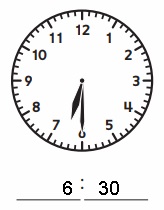
Explanation:
The time shown on the clock is 6:30.
Question 3.
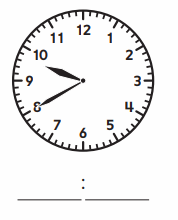
Answer:
9:40,
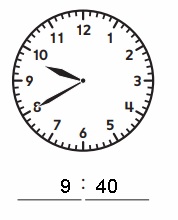
Explanation:
The time shown on the clock is 9:40.
Question 4.

Answer:
1:25,
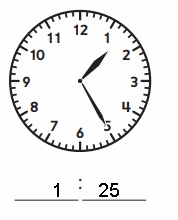
Explanation:
The time shown on the clock is 1:25.
Question 5.
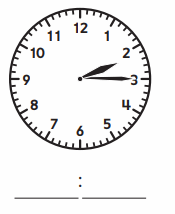
Answer:
2:15,

Explanation:
The time shown on the clock is 2:15.
Draw the hands to match the time.
Question 6.
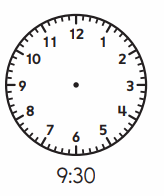
Answer:

Explanation:
Drawn the hour hand as 9 and the minute hand at 6
to show the time as 9:30.
Question 7.

Answer:

Explanation:
Drawn the hour hand as 4 and the minute hand at 1
to show the time as 4:05.
Question 8.
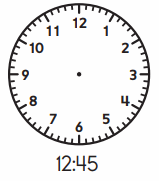
Answer:

Explanation:
Drawn the hour hand as 12 and the minute hand at 9
to show the time as 12:45.
Question 9.
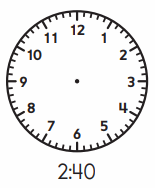
Answer:

Explanation:
Drawn the hour hand as 2 and the minute hand at 8
to show the time as 2:40.
Practice
Solve the facts.
Question 10.
7 + 5 = _12_
Answer:
7 + 5 = 12,
Explanation:
Adding 5 to 7 we will get 12.
Question 11.
_8_ + 6 = 14
Answer:
8 + 6 = 14,
Explanation:
Subtracting 6 from 14 we will get missing number as 8,
So 8 + 6 = 14.
Question 12.
3 + _7_ = 10
Answer:
3 + 7 = 10,
Explanation:
Subtracting 3 from 10 we will get missing number as 7,
So 3 + 7 = 10.
Question 13.
4 + 9 = _13_
Answer:
4 + 9 = 13,
Explanation:
Adding 9 to 4 we will get 13.
Everyday Math Grade 2 Home Link 4.3 Answer Key
A.M. and P.M.
Family Note
Today we discussed the meanings of a.m. and p.m. Your child learned that a.m. describes times from 12:00 midnight to 12:00 noon and that p.m. describes times from 12:00 noon to 12:00 midnight. We identified events that occur throughout the day and labeled them on a 24-hour timeline.
Talk with your child about events that take place during your family’s day, such as eating dinner, doing homework, reading, getting ready for bed, sleeping, and waking up.
Please return this Home Link to school tomorrow.
Question 1.
Draw pictures of things that happen at home.
Write the time for each using A.M. and P.M.

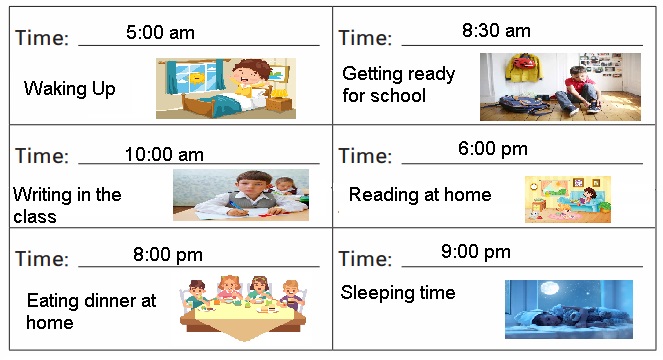
Explanation:
Drawn the pictures of things that happen at home,
Wrote the time for each using A.M. and P.M as
shown above as
1. Waking up at 5:00 am,
2. Getting ready for school 8:30 am,
3. Writing in the class 10:00 am,
4. Reading at home 6:00 pm,
5. Eating dinner at home 8:00 pm and
6. Sleeping time around 9:00 pm respectively.
Practice
Question 2.
6 + 3 = _9__
Answer:
6 + 3 = 9,
Explanation:
Adding 3 to 6 we will get 9.
Question 3.
5 + _7_ = 12
Answer:
5 + 7 = 12,
Explanation:
Subtracting 5 from 12 we will get missing number as 7,
So 5 + 7 = 12.
Question 4.
_2_ + 8 = 10
Answer:
2 + 8 = 10,
Explanation:
Subtracting 8 from 10 we will get missing number as 2,
So 2 + 8 = 10.
Question 5.
_9_ = 5 + 4
Answer:
9 = 5 + 4,
Explanation:
Adding 4 to 5 we will get 9.
Everyday Math Grade 2 Home Link 4.4 Answer Key
Times of Day
Family Note
Your child is learning how to tell time by writing times displayed on an analog clock (a clock with an hour hand and a minute hand) and by setting the hands on an analog clock to show specific times. Your child should have brought home a clock to use while completing the exercises on this page. Ask your child to use the clock to show you other times that don’t appear here.
Please return this Home Link to school tomorrow.
Question 1.
What number do the base-10 blocks show?
a. 
b. 
Answer:
a. The base – 10 blocks show the number 374,
b. The base – 10 blocks show the number 507,
Explanation:
a. Given blocks are 3 – 10 X 10 blocks so 3 X 100 blocks = 300,
7 X 10 blocks = 70 and 4 X 1 block = 4,
therefore 300 + 70 + 4 = 374 so
the base – 10 blocks show the number as 374,
b. Given blocks are 5 – 10 X 10 blocks so 5 X 100 blocks = 500
and 7 X 1 block = 7,
therefore 500 + 7 = 507 so
the base – 10 blocks show the numberas 507.
Question 2.
Write a number with 7 in the hundreds place, 0 in the ones place, and 4 in the tens place. _740__
Answer:
The number with 7 in the hundreds place, 0 in the ones place and
4 in the tens place is 740,
Explanation:
Given to write the number with 7 in the hundreds place,
0 in the ones place and 4 in the tens place therefore it is
7 X 100 + 0 X 1 + 4 X 10 = 700 + 0 + 40 = 740 respectively.
Question 3.
Write a number with 3 in the tens place, 6 in the ones place, and 9 in the hundreds place. _936__
Answer:
The number with 3 in the tens place, 6 in the ones place and
9 in the hundreds place is 936,
Explanation:
Given to write the number with 3 in the tens place,
6 in the ones place and 9 in the hundreds place therefore
it is 3 X 10 + 6 X 1 + 9 X 100 = 30 + 6 + 900 = 936 respectively.
Question 4.
In 806, there are _8_ hundreds, _0_ tens, and _6_ ones.
Answer:
806 = 8 hundreds, 0 tens and 6 ones,
Explanation:
Given to write 806 so they are 8 is at hundreds place,
0 is at tens place and 6 is at ones place therefore
806 = 8 hundreds, 0 tens and 6 ones.
Question 5.
In 235, there are _2_ hundreds, _3_ tens, and _5_ ones.
Answer:
235 = 2 hundreds, 3 tens and 5 ones,
Explanation:
Given to write 235 so they are 2 is at hundreds place,
3 is at tens place and 5 is at ones place therefore
235 = 2 hundreds, 3 tens and 5 ones.
Everyday Math Grade 2 Home Link 4.5 Answer Key
Comparing Numbers
Family Note
Today we practiced comparing numbers by playing a game called Number Top-It. (See directions below.) You can make cards by writing the numbers 0−9 on index cards (make four cards for each number), or you can use a deck of playing cards. If you use playing cards, you will first need to change the four queens to 0s, change the four aces to 1s, and remove the jacks, kings, and jokers.
Please return this Home Link to school tomorrow.
Play Number Top-It with someone at home:
- Shuffle the cards. Place the deck number-side down.
- Take turns drawing cards until each player has three cards.
- Each player uses their three cards to make a 3-digit number and reads the number aloud.
- Compare the two numbers. The player with the larger number for the round scores 1 point, and the player with the smaller number scores 2 points.
- Play five rounds per game. When you’ve used all the cards in the deck, shuffle them to make a new deck. The player with the fewest points at the end of five rounds wins the game.
Answer:

player 2 wins the game with 7 points fewer to player 1,
Explanation:
Shuffled the cards. Placed the deck number-side down.
Took turns drawing cards until each player has three cards.
Each player uses their three cards to make a 3-digit number and
reads the number aloud and wrote as shown above
compared the two numbers and the player with the
larger number for the round scored 1 point and the player
with the smaller number scored 2 points in
Round 1 – player 1 scored 1 pt and player 2 scored 2 pts,
Round 2 – player 1 scored 2 pts and player 2 scored 1 pt,
Round 3 – player 1 scored 2 pts and player 2 scored 1 pt,
Round 4 – player 1 scored 2 pts and player 2 cored 1 pt and in
Round 5 – player 1 scored 1 pt and player 2 cored 2 pts,
Played five rounds as the player with the fewest points at
the end of five rounds wins the game.
So Player 1 scored 8 points and Player 2 scored 7 points,
therefore Player 2 wins the game with 7 points.
Practice
Solve the facts.
Question 1.
5 + 9 = _14_
Answer:
5 + 9 = 14,
Explanation:
Adding 9 to 5 we will get 14.
Question 2.
_16_ = 9 + 7
Answer:
16 = 9 + 7,
Explanation:
Adding 7 to 9 we will get 16.
Question 3.
_8_ + 4 = 12
Answer:
8 + 4 = 12,
Explanation:
Subtracting 4 from 12 we will get missing number as 8,
So 8 + 4 = 12.
Question 4.
2 + _7_ = 9
Answer:
2 + 7 = 9,
Explanation:
Subtracting 2 from 9 we will get missing number as 7,
So 2 + 7 = 9.
Everyday Math Grade 2 Home Link 4.6 Answer Key
Using Base-10 Blocks
Family Note
Today we explored how to write numbers shown by base-10 blocks. In this lesson, we decided that making a trade can sometimes help us find the number the blocks represent. Making trades with base-10 blocks will be revisited throughout the year in games and addition and
subtraction situations.
Please return this Home Link to school tomorrow.
Question 1.
Shane had these base-10 blocks:

He made a trade. Then he showed the same number in base-10 short hand:
 The number shown here is .
The number shown here is .
Answer:
The number is 145,
Explanation:
Shane have base-10 blocks as
1 X 100 + 3 X 10 +15 X 1 = 100 + 30 + 15 = 145,
therefore shane have the number as 145.
Question 2.
Suppose you have these base-10 blocks:

Make a trade. Then draw the base-10 blocks and write the number shown. See the example in Problem 1. The number shown here is. __328_
Answer:
 ,
,
the number shown is 328,
Explanation:
Made a trade and showed the same number in base-10 short hand
because we have 12 X 10 + 2 X 100 + 8 X 1 =
120 + 200 + 8 = 328, therefore the number shown is 328 with
2 lines for 10 each, 3 square blocks for 100 each and 8 small dots for
1 each as shown above.
Everyday Math Grade 2 Home Link 4.7 Answer Key
Making Exchanges
Family Note
Today your child used base-10 blocks to represent, add, and subtract 2-digit numbers. When adding, children often exchange 10 ones for 1 ten to represent the final number using the fewest possible blocks. When subtracting, children often need to exchange 1 ten for 10 ones to have enough ones to take away. Ask your child to explain how they represent numbers for the problems below.
Please return this Home Link to school tomorrow.
Write the numbers shown by the blocks.
Question 1.

What is the total value?
Use base-10 shorthand to show your answer:
Answer:
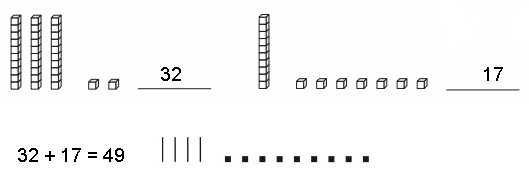
Explanation:
The numbers shown by the blocks are
3 X 10 + 2 X 1 = 30 + 2 = 32 and 1 X 10 + 7 x 1 = 10+ 7 = 17,
The total value is 32 + 17 = 49 shown
base-10 shorthand with 4 long lines 10 each and
9 small dots for 1 each as shown above.
Question 2.

What is the total value?
Use base-10 shorthand to show your answer:
Answer:
 Explanation:
Explanation:
The numbers shown by the blocks are
2 X 10 + 6 X 1 = 20 + 6 = 26 and 3 X 10 + 4 X 1 = 30 + 4 = 34,
The total value is 26 + 34 = 60 shown
base-10 shorthand with 6 long lines 10 each as shown above.
Question 3.

Use base-10 shorthand to show how you can take away 3 cubes.
Hint: Exchange 1 long for 10 cubes.
What is the value of the blocks that are left? _29_
Talk to someone at home about making exchanges
between base-10 longs and cubes.
Answer:
32,

The value of the blocks that are left are 29,
Explanation:
Given 3 X 10 + 2 X 1 = 30 + 2 = 32 now
shown above as 2 lines for 10 each then took 1 block from
10 blocks (10 – 9 = 1), so I made 9 small dots of 1 block each to
represent 9 and took 1 left block to 2 individual blocks as
1 + 2 = 3 and made 3 cross marks to show 3 blocks taken away,
therefore the value of the blocks that are left are
32 – 3 = 29 as shown above.
Everyday Math Grade 2 Home Link 4.8 Answer Key
Measuring with a Foot-Long Foot
Family Note
Today we talked about the importance of measuring with standard units so that we all get the same results. You and your child can use the foot-long (12-inch) foot to measure objects or distances around your home. Objects or distances will usually be longer or shorter than a whole number of feet,
so encourage your child to use language such as “about __ feet,” “a little less/more than __ feet,” or “about halfway between __ and __ feet.”
Please return this Home Link to school tomorrow
Follow these steps:
1. Cut out the foot-long foot on the next page.
2. Measure three objects or distances to the nearest foot.
Write your measurements in the chart.
3. Have someone else measure the same things.
Write their measurements in the chart.
4. Agree on a measurement that is close.
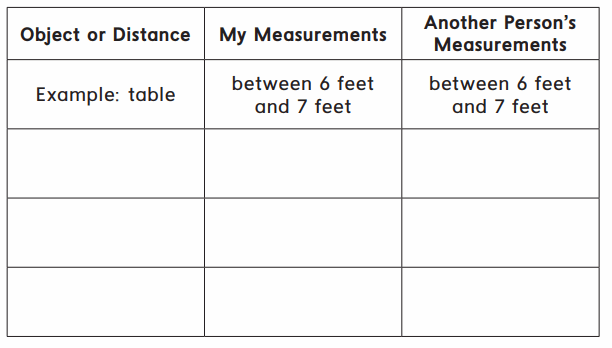
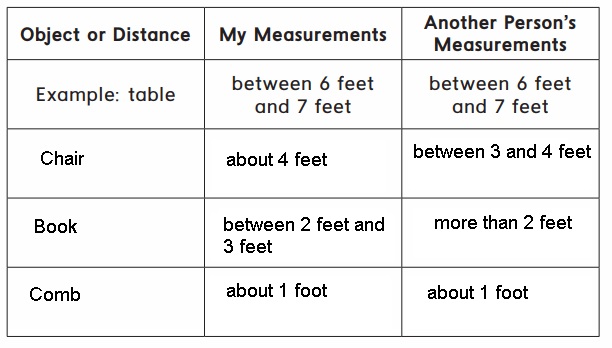
Explanation:
Measured three objects or distances to the nearest foot.
Wrote my measurements in the chart and
wrote someone else measurements for the
same things in the chart as shown above and
agreed on a measurement that is close as
1. Agreed Chair for about 4 feet,
2. Agreed Book for more than 2 feet and
3. Agreed Comb for about 1 foot respectively.
Everyday Math Grade 2 Home Link 4.9 Answer Key
Measuring in Inches
Family Note
In today’s lesson your child learned to measure objects in inches with a 12-inch (foot-long) ruler. We also discussed the important concept that an inch ruler is composed of a series of inch-long spaces. We measured short objects first with inch-long blocks and then with 12-inch rulers to show that the measurements are the same.
Please return this Home Link to school tomorrow.
Question 1.
Cut out the 6-inch ruler below.
Measure four short objects or distances to
the nearest inch. Record your measures below.

Answer:
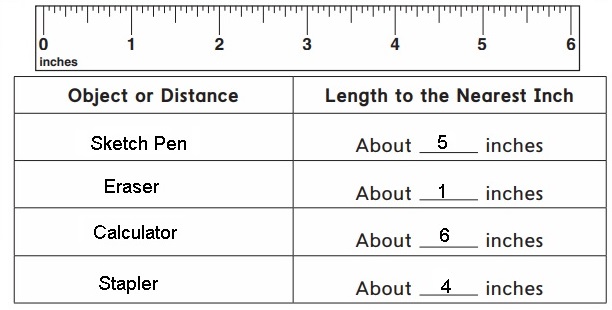
Explanation:
Cutted out the 6-inch ruler above.
Measured four short objects or distances to the
nearest inch and recorded my measures above as
1. Sketch pen about 5 inches,
2. Eraser about 1 inches,
3. Calculator about 6 inches and
4. Stapler about 4 inches respectively.
Practice
Solve the facts.
Question 2.
6 + 8 = _14__
Answer:
6 + 8 = 14,
Explanation:
Adding 8 to 6 we will get 14.
Question 3.
9 + _6_ = 15
Answer:
9 + 6 = 15,
Explanation:
Subtracting 9 from 15 we will get missing number as 6,
So 9 + 6 = 15.
Question 4.
7 + 6 = _13__
Answer:
7 + 6 = 13,
Explanation:
Adding 6 to 7 we will get 13.
Question 5.
_13_ = 8 + 5
Answer:
13 = 8 + 5,
Explanation:
Adding 5 to 8 we will get 13.

Everyday Math Grade 2 Home Link 4.10 Answer Key
Measuring in Centimeters
Family Note
Today your child learned about the metric unit of length called the centimeter. The inch, introduced in the previous lesson, is a length unit in the U.S. customary system of measurement. With the exception of the United States, most countries use the metric system in everyday life. People in the United States and the rest of the world use the metric system for scientific purposes. It is important for your child to become proficient in both measurement systems.
Please return this Home Link to school tomorrow.
Question 1.
Cut out the 10-centimeter ruler below.
Measure three short objects or distances to the
nearest centimeter.
Record your measurements in the table.

Answer:
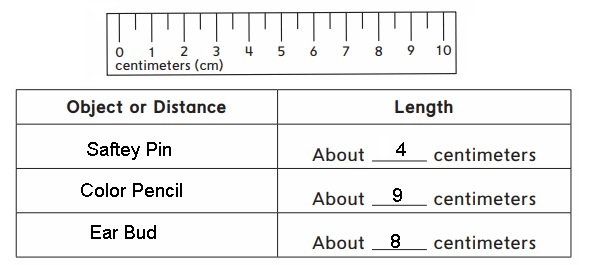
Explanation:
Cutted out the 10-centimeter ruler above.
Measured three short objects or distances to
the nearest centimeters and recorded my
measures in the table above as
1. Saftey pin about 4 centimeters,
2. Color pencil about 9 centimeters,
3. Ear bud about 8 centimeters respectively.
Practice
Solve the facts.
Question 2.
6 + 2 = _8_
Answer:
6 + 2 = 8,
Explanation:
Adding 2 to 6 we will get 8.
Question 3.
7 + _5_ = 12
Answer:
7 + 5 = 12,
Explanation:
Subtracting 7 from 12 we will get missing number as 5,
So 7 + 5 = 12.
Question 4.
_9_ + 3 = 12
Answer:
9 + 3 = 12,
Explanation:
Subtracting 3 from 12 we will get missing number as 9,
So 9 + 3 = 12.
Question 5.
_15_ = 7 + 8
Answer:
15 = 7 + 8,
Explanation:
Adding 8 to 7 we will get 15.

Everyday Math Grade 2 Home Link 4.11 Answer Key
Measuring to the Nearest Centimeter
Family Note
In today’s lesson your child measured the length of a long path to the nearest inch and the nearest centimeter (cm). Ask your child to explain how to measure each section of the path on this page. Encourage your child to measure objects at home. If you don’t have a ruler at home, have your child cut out and use the 10-centimeter ruler at the bottom of the page.
Please return this Home Link to school tomorrow
A ladybug walked around the garden.
Measure each part of its path to the nearest centimeter.
Record the measurements in the table.
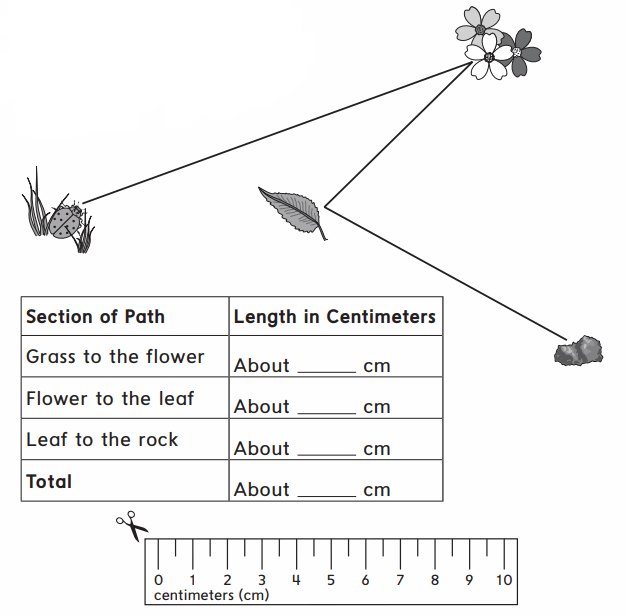
Answer:

Explanation:
Given a ladybug walked around the garden,
Measured each part of its path to the nearest centimeter.
Recorded the measurements in the table above as
from grass to the flower it measures about 12 cm,
from flower to the leaf it measures about 6 cm and
from leaf to the rock it measures about 8 cm, So in total
the ladybug walked around the garden is
12+ 6 + 8 = 26 cm.